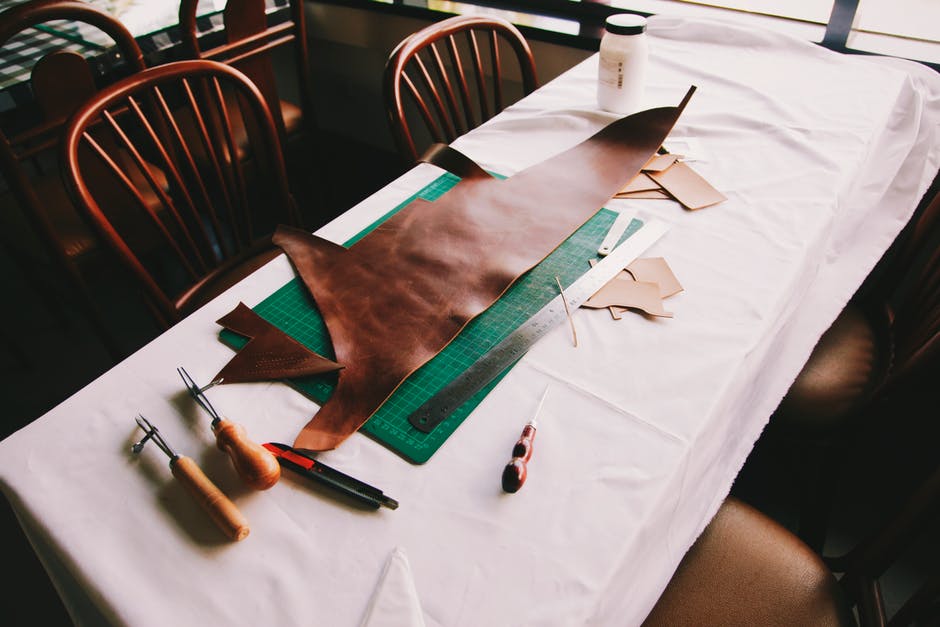Leather production has been around for a long time. It is an ancient human activity dating back to about the fifth millennium BC when the Sumerians were fashioning long dresses from cured animal skins. At about that time, the ancient Egyptians also produced leather gloves and the Phoenicians used it in water pipes construction. A lot of the leather we see around today is a by-product of the meat industry. They are gotten from cows because of their availability, quality, and the size of the leather. The leather is also gotten from different animals, such as sheep, pigs, deer, kangaroos, and horses. More exotic leathers are obtained from alligators, ostriches, frogs, snakes, and a variety of fish.
Do you have an interest in leather working or know someone who is? Check out our gift ideas for leather workers and leather crafters!
As leathers are different, so is their qualities, uses, and appearances. The quality of a lather obtained from a particular animal is determined by different factors. Some examples of these factors include the conditions in which the animal lived, climate or exposure to disease, and nutrition. Other factors that can affect the leather quality have their influence when the animal is slaughtered, and these include tanning chemicals, dyes, and stains, as well as the shipping and handling methods.
Types of Leather
- Full Grain Leather: The top layer of the hide is referred to as the Full Grain Leather. This layer is usually treated with aniline dyes that are soluble and do not mask the natural surface of the hide. Sometimes, it is treated with a semi-aniline dye, which gives the leather a thin protective coat on top and prevents it from staining. This part of the leather is the strongest and most durable because of its vertical fibers, and it does not peel or crack, tear or puncture. The grain pattern is tight and therefore, resistant to moisture.
One of the reasons the Full Grain leather is beautiful is because of its unique appearance as every piece of it tells the story of the animal. As it ages, it becomes more beautiful while developing a rich patina. It is the best leather money can buy and usually the most expensive.
- Top Grain Leather: This name is a bit confusing as this part is not the top layer of the hide but the second. The leather surface is removed by buffing or sanding to get rid of the ‘imperfections.’ Although this gives the leather a more uniform appearance, it also makes it less durable than Full Grain Leather and it will weaken or fade faster. Top Grain Leather is most commonly used for the production of quality goods since it is thinner, less expensive, and more flexible.
A different type of Top Grain Leather is ‘Corrected’ leather. This type of Top Grain Leather undergoes an extensive process of buffing, sanding, stamping, and dyeing to make it have a uniform appearance, which helps remove all natural markings.
- Nubuck Leather: This type of leather is made from the hide of elk or deer. Nubuck shoes were first made popular in the 1930s when the Duke of Windsor visited America. Nubuck is a type of Top Grain Leather that is yet to undergo any form of processing other than brushing and polishing so that the short protein fibers produce a velvet surface. They are similar to suede but more expensive. A common way to differentiate between Nubuck and suede is that when you run your hand over a Nubuck, the lush surface will change shade. They are also thicker and stronger than suede. It can be colored and dyed or white. Its surface is rougher in appearance than suede and may retain natural markings.
- Suede: various terms are used to describe suede leather, such as split leather, corrected leather, embossed leather, coated leather, Napa leather, painted leather, and more. Suede is obtained from the inner layer of the hide. That is the side originally in contact with the animal flesh. The surface is buffed and sanded and the resulting leather is more flexible and softer than Nubuck. Suede is prone to staining because of its absorbent surface.
- Faux or Synthetic Leather: Faux or synthetic leathers are by-products of the chemical industry and have been in production since the 1940s. These names are often used to describe specific end uses of synthetic leather products. They come under different brand names and are classified into two main categories: polyurethane (PU) and polyvinyl chloride (PVC, Vinyl).
For example, vinyl upholstery is made from two different synthetic materials, polyvinyl chloride (PVC) and plasticizers (phthalic acid). It can also be used for car interiors and utility furniture, such as in budget restaurants or hospitals. They are durable and easy to maintain and become sticky and unpleasant when they come in contact with the human skin.
Polyurethane upholstery is an upholstery made up of synthetic materials, among them a flexible polymer, and a layer of other material that functions as a backing fabric (such as cotton or shredded leather). This type of leather is also known as bonded leather, reconstructed leather or blended leather. The fabric is more flexible, softer, and to some extent, more breathable. It is more expensive than Vinyl but cheaper than leather.
When selecting the best leather for any purpose, or buying ready-made leather products, it is important to understand the different types of leather and their processes. Therefore, this leather terminology and glossary, which defines the general terms and different types of leather and their process, will help you understand the different types of leather. We recommend that you get acquainted with these terms and ask questions before making any purchase decision.
